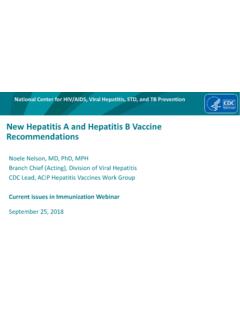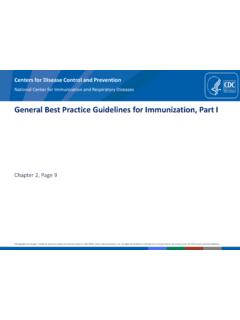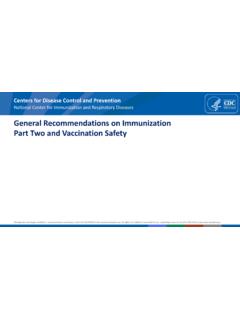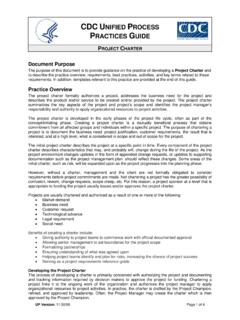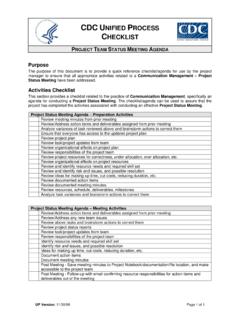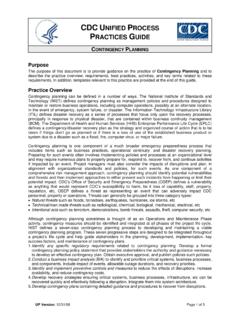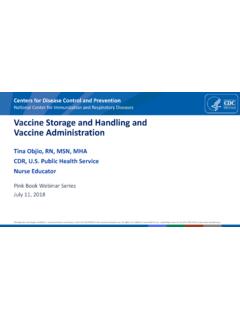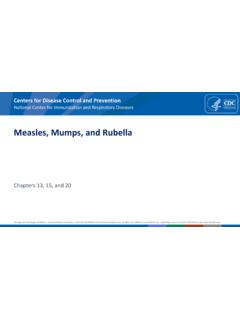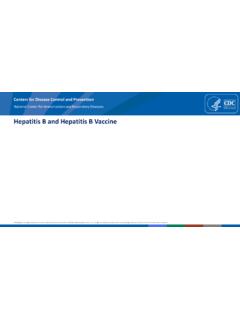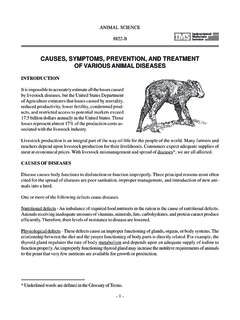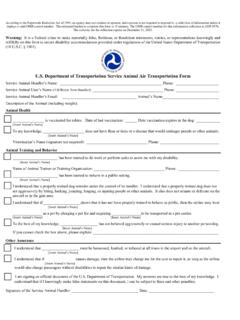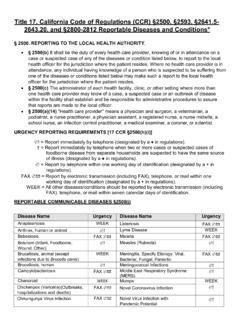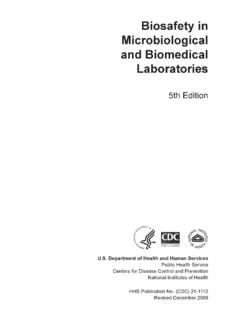Transcription of Principles of Vaccination - Centers for Disease Control ...
1 Centers for Disease Control and Prevention National Center for Immunization and Respiratory Diseases Principles of Vaccination Pink Book Webinar Series Chapter 1. June 5, 2019. JoEllen Wolicki, RN, BSN. Nurse Educator Photographs and images included in this presentation are licensed solely for CDC/NCIRD online and presentation use. No rights are implied or extended for use in printing or any use by other CDC CIOs or any external audiences. 1 Immunity Immunity Self vs. nonself . Protection from infectious diseases Usually indicated by the presence of antibody Generally specific to a single organism Antigen Live or inactivated substances ( , viruses, bacteria, toxins).
2 - Capable of stimulating an immune response Antigen = antibody generator Virus with antigens on surface Antibody Protein molecules (immunoglobulins). - Produced by B cells (lymphocytes) to bind to a corresponding antigen (lock and key mechanism) B-Cell - Helps neutralize antigen and prepare it for destruction - B cells develop in the bone marrow Antibodies Arms of the Immune System Humoral - Production of antibodies that are specific to a certain antigen or group of antigens Antibody - Antibodies attach to invading organism Antibody and interfere with its ability to produce more invading organisms Antigen Antibodies attaching to antigens Arms of the Immune System Cell-mediated T lymphocytes (T-cells).
3 - Involves the activation of T-cells, macrophages, and other substances that eliminate the antigen - T-cells mature in the thymus gland T-Cell Types of Immunity: Active and Passive Passive Immunity Transfer of antibody produced by one human or animal to another Temporary protection that wanes with time Transfer of antibody through placenta important to protect infants Passive Immunity Video Sources of Passive Immunity Many types of blood or blood products Homologous pooled human antibody (immune globulin or IG). - IgG antibody from the blood of thousands of American adult donors - Hepatitis A and measles postexposure prophylaxis (PEP).
4 Sources of Passive Immunity Homologous human hyperimmune globulin ( , HBIG). - Taken from donors with high concentrations of a specific antibody - HBIG, RIG, TIG, VariZIG, VIG. Heterologous hyperimmune serum - Antitoxin ( , diphtheria antitoxin). - Serum sickness Sources of Passive Immunity Monoclonal antibodies - Derived from a single type, or clone, of antibody-producing cells (B cells). Immune globulin from human sources is polyclonal (contains many different kinds of antibodies). - Antibody is specific to a single antigen or closely related group of antigens - Used for diagnosis of and therapy for certain cancers and autoimmune and infectious diseases, as well as prevention of transplant rejection - Monoclonal-antibody-derived drugs end in mab ( , Palivizumab).
5 Antibody for Prevention of RSV. Palivizumab (Synagis). - Monoclonal - Contains only RSV antibody - Will not interfere with the response to a live-virus vaccine Active Immunity Protection produced by a person's own immune system Lasts for many years, often lifetime Active Immunity Video Sources of Active Immunity Infection with Disease -causing Vaccination form of organism Vaccination Active immunity produced by vaccine - Vaccine delivers a dead or attenuated (weakened, nonpathogenic). form of the pathogen Immunity and immunologic memory similar to natural infection but without risk of Disease - Immunologic memory allows for an anamnestic response after the primary immune response so that antibody reappears when the antigen is introduced Factors that Affect Immune Response to Vaccines Presence of maternal antibodies Nature and amount of antigen in vaccine Route of administration Presence of an adjuvant (ingredient that promotes a stronger immune response).
6 Storage and handling of vaccine Vaccinee - Age - Nutritional status - Genetics - Coexisting Disease 2 Classification of Vaccines Classification of Vaccines Live, attenuated (weakened form of the organism). Viral or bacterial Inactivated (nonlive or fraction of the organism). Viral or bacterial Protein-based ( , toxoid or subunit vaccines). Polysaccharide based ( , bacterial cell wall polysaccharide). 3 Principles of Vaccination Principles of Vaccination General rule: The more similar a vaccine is to the natural Disease , the better the immune response to the vaccine Live Attenuated Vaccine Vidoe Live, Attenuated Vaccines Attenuated (weakened) form of the "wild" virus or bacterium Must replicate to produce an immune response Immune response virtually identical to natural infection Usually produce immunity with 1 dose*.
7 *Except those administered orally Individual Response to Live Vaccine 120. 100. Antibody level 80. Protective level 60. 40. 20. 0. Pre Post 1 Post 2 Post 3 5 yrs Dose Population Response to Live Vaccine 100. 90. 80. Percent Immune 70. 60. 50. 40. 30. 20. 10. 0. Pre Post 1 Post 2 Post 3. Dose Herd Immunity/. Community Immunity When a significant portion of the population is immune and provides protection for individuals who are not immune Live, Attenuated Vaccines Severe reactions possible Interference from circulating antibody Fragile must be stored and handled carefully Live, Attenuated Vaccines Viral MMR, varicella, zoster vaccine live (ZVL), yellow fever, rotavirus, LAIV.
8 (intranasal influenza), smallpox (vaccinia), oral adenovirus, oral polio*. Bacterial BCG,** oral typhoid, oral cholera * Not used in the United States **Not used in the United States for routine TB protection Inactivated Vaccines Whole Fractional Viruses Protein-based Toxoid Subunit Bacteria Polysaccharide-based Pure Conjugate Inactivated Vaccine Video Inactivated Vaccines Cannot replicate Less affected by circulating antibody than live vaccines - Example: HepB vaccine and HBIG for perinatal hepatitis B PEP. Always require multiple doses Immune response mostly humoral Antibody titer diminishes with time May require periodic supplemental doses Individual Response to Inactivated Vaccine 100.
9 90. 80. Antibody level 70. 60. 50. 40. 30 Protective level 20. 10. 0. Pre Post 1 Post 2 Post 3 Post 4 5 yrs Dose Population Response to Inactivated Vaccine 100. 90. 80. Percent immune 70. 60. 50. 40. 30. 20. 10. 0. Pre Post 1 Post 2 Post 3 Post 4. Dose Inactivated Vaccines Whole Viral Polio, hepatitis A, rabies, Japanese encephalitis, and influenza*. Bacterial Pertussis,* typhoid,* cholera,* plague*. *Not available in the United States Inactivated Vaccines Fractional Subunit Hepatitis B, influenza, acellular pertussis, human papillomavirus, and anthrax Polysaccharide vaccines Toxoid Diphtheria, tetanus Capsular Polysaccharide Capsular Polysaccharide Pure Polysaccharide Vaccines Immune response typically T-cell-independent Not consistently immunogenic in children younger than 2 years of age No booster response Antibody with less functional activity (IgM rather than IgG).
10 Immunogenicity improved by conjugation Polysaccharide Vaccines Pure polysaccharide Conjugate polysaccharide Pneumococcal (PPSV23) Haemophilus influenzae type b (Hib). Salmonella Typhi (Vi) Pneumococcal (PCV13). Meningococcal Genetically Engineered Vaccines Viral: hepatitis B, human papillomavirus, influenza (RIV), influenza (LAIV), and rotavirus (RV5). Bacterial: meningococcal B. New Design for Schedule Web Pages Recommended Immunization Schedules for Health Care Providers Accessed 5/31/2019. 4 Resources Pink Book Webinar Series Resources Comprehensive list of resources for ALL the webinars Located on the webpage for this webinar with the: Webinar slides Archived recast Webinar questions and answers Transcript
